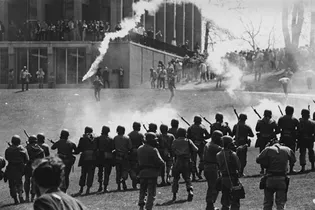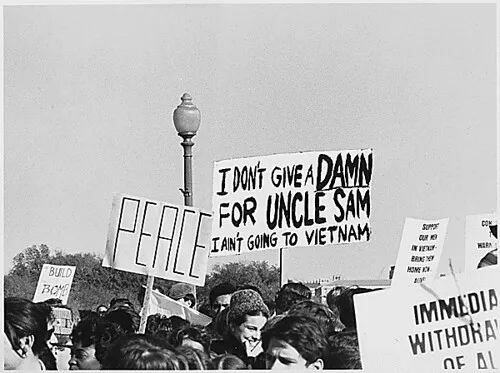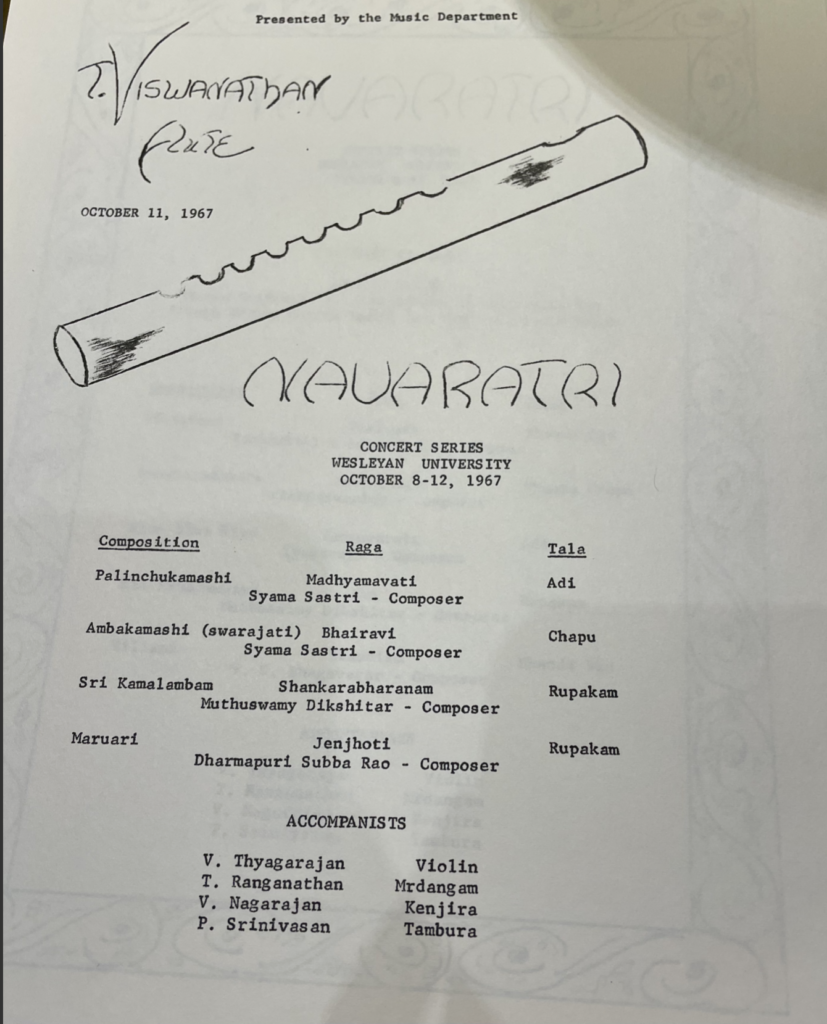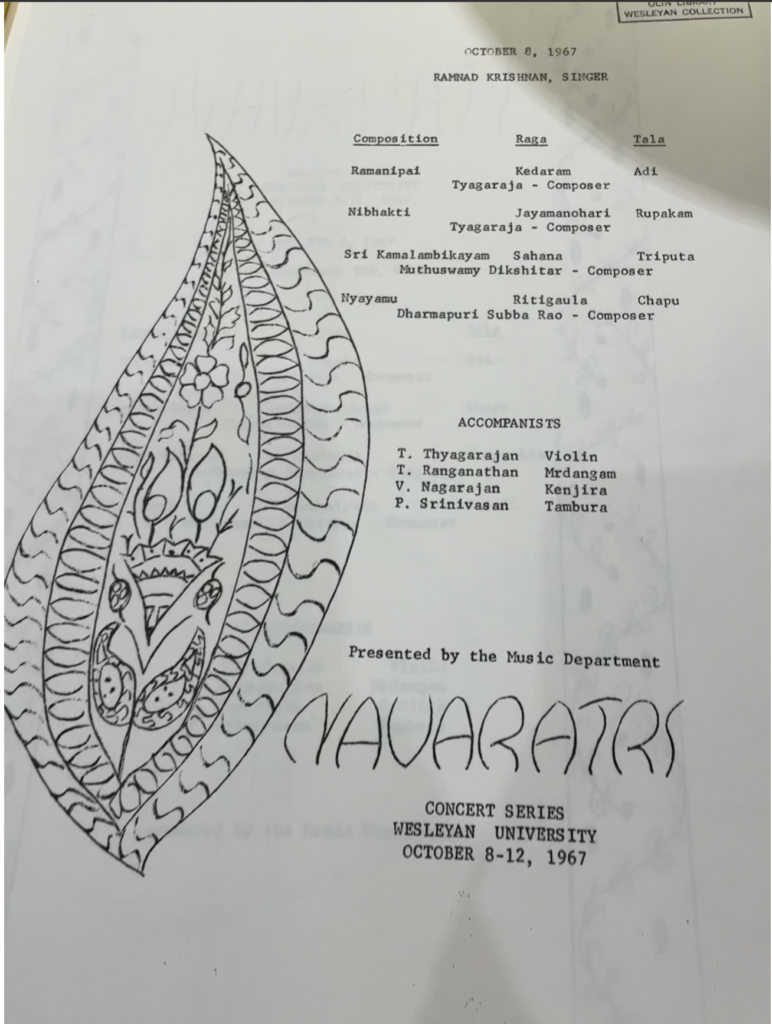Spiritual Sounds in the United States and at Wesleyan University
Classical Indian Music and the Ethos of the Psychedelic 60s
“AMERICAN EARS WILL BE OPENED TO A NEW WORLD OF SOUND
AND HEARTS WILL BE RE-OPENED TO THE OLDEST, DEEPEST EMOTIONS”
Ravi Shankar Flyer: Music Department Records, Box: 3, Folder: 5. Wesleyan University Special Collections & Archives.
The Vietnam War
The Vietnam War, which was waged from 1954 to 1975, began as a conflict between the communist government of North Vietnam, including the guerilla group known as the Viet Cong, and South Vietnam, which allied with the United States. The U.S. committed troops to South Vietnam in 1965, effectively treating the Southeast Asian conflict as a proxy to its Cold War with the Soviet Union (Hall 2004). The Cold War also led to the passage of the 1965 Hart-Cellar Act which set higher quotas for immigration from Asian countries for highly skilled workers (Keely 1971). America’s involvement in the Vietnam War immediately inspired public dissent, especially amongst the nation’s youth and students. The first of such protests to gain national attention involved the participation of about 3,000 people at the University of Michigan in 1965. By 1969, popular support for the war had severely declined and protest demonstrations boasted the highest numbers they had seen so far. The movement ultimately peaked after the United States invaded Cambodia in April of 1970. This military maneuver inspired a new wave of campus protests, including the Kent State University protest which ultimately ended in tragedy when four people were killed by National Guardsmen. Five hundred college campuses across the country shut down following this tragic event and about a hundred thousand Americans flocked to Washington D.C. to protest the act of violence. Five days after this protest on May 9th, two more students were killed by Mississippi police at Jackson State University. The United States government pulled back militarily in reaction to mass dissent and protest and ultimately ended involvement in Vietnam with the Paris Peace Agreement in 1973 (Hall 2004).
The Rise of Counterculture and Indian Classical Music
The antiwar protestors were often also members of America’s counterculture, sometimes referred to as hippies, who distinguished themselves from conventional society through hairstyles, clothing, and cultural interests, like for example, music. In particular, South Asian music which is rooted in Hinduism and its philosophies, took off amongst the counterculture youth. They perceived Hinduism as particularly free, and spiritual in a way that contrasted their perceptions of Christian American society as rigid and conformist. Members of the counterculture also drew connections between Gandhi’s peaceful movement for India’s independence with the Civil Rights and anti-war movements of the United States. In concurrence, popular musicians like the Beatles and George Harrison found inspiration in Hinduism and Indian music, especially because of legendary sitarist Ravi Shankar (Pfändtner 2019). Ravi Shankar rose to prominence in American society in the 1960s following his famed performance at the Monterey International Pop Festival in 1967. That same year, he was named Artist of the Year by Billboard. The virtuosic performer is credited with bringing South Asian classical music to the United States, though he was uneasy about his association with “hippies” who were experiencing a “generational yearning for a spiritual life beyond the banality of the material one… like a last gasp of the Western soul” (Craske 2020). He believed members of the counterculture wrongfully associated his music with illicit drugs and material spirituality, suggesting his belief that members of the counterculture appropriated Indian classical music. Though Shankar was uncomfortable with his fame amongst hippies, his role in popularizing Indian classical music and the use of sitar is undeniable. Shankar had a meaningful and lasting influence on the music of artists like George Harrison that was “clearly more than a fad” and thus influenced a shift in pop culture (Bor 1998).
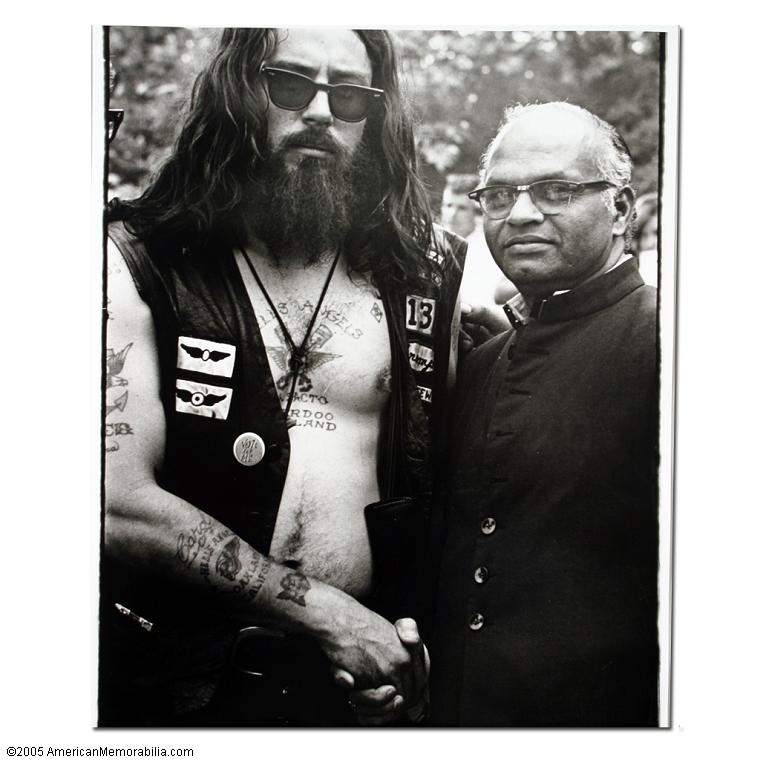
World Music at Wesleyan University
Ultimately, the history of the Vietnam War and the subsequent development of counterculture which popularized Indian classical music is also reflected in the history of Wesleyan University. While students protested the United States’ involvement in Southeast Asia, the University began offering more extensive World Music programming and even established a Doctoral Program in Ethnomusicology. Ravi Shankar himself visited Wesleyan and offered a concert in the Memorial Chapel in the early 1960s while on tour with The Asia Society Performing Arts Program. Wesleyan hosted many other Indian musicians throughout the 1960s to perform in Concert Series such as Navaratri in 1967. This series took place from October 8-12 and celebrated the Hindu festival of Navaratri, which dedicates 9 nights to the Goddess Durga and celebrates her victory over Mahisasura, a buffalo demon (Gairola 2023). The Wesleyan University Music Department offered more concert programming from South Asian performers in the 1960s. The department even established a doctoral program in Ethnomusicology in the 1960s. In the proposal for the program, the department writes that the program was inspired by the fact that “a marked interest in the ‘rest of the world’ characterizes much of American education today.” The proposal asserts that this “is in part a response to the political and military commitments of the United States from all over the world” (A Proposal for a Ph. D. in Ethnomusicology, Music Department Series 1, Box: 1, Folder: 1. Special Collections & Archives). This illustrates that America’s involvement in warfare in places like Southeast Asia caused American students to develop an interest in other cultures–for example, Hinduism and Indian classical music–which is then reflected in what programs are offered by the United States academic institutions, like Wesleyan. The fact that the 1965 Hart-Cellar Immigration Act allowed for greater numbers of immigrants from Asian countries to move to the U.S. also gave World Music programs greater potential because teaching professionals were afforded a better opportunity to seek American citizenship (Keely 1971).
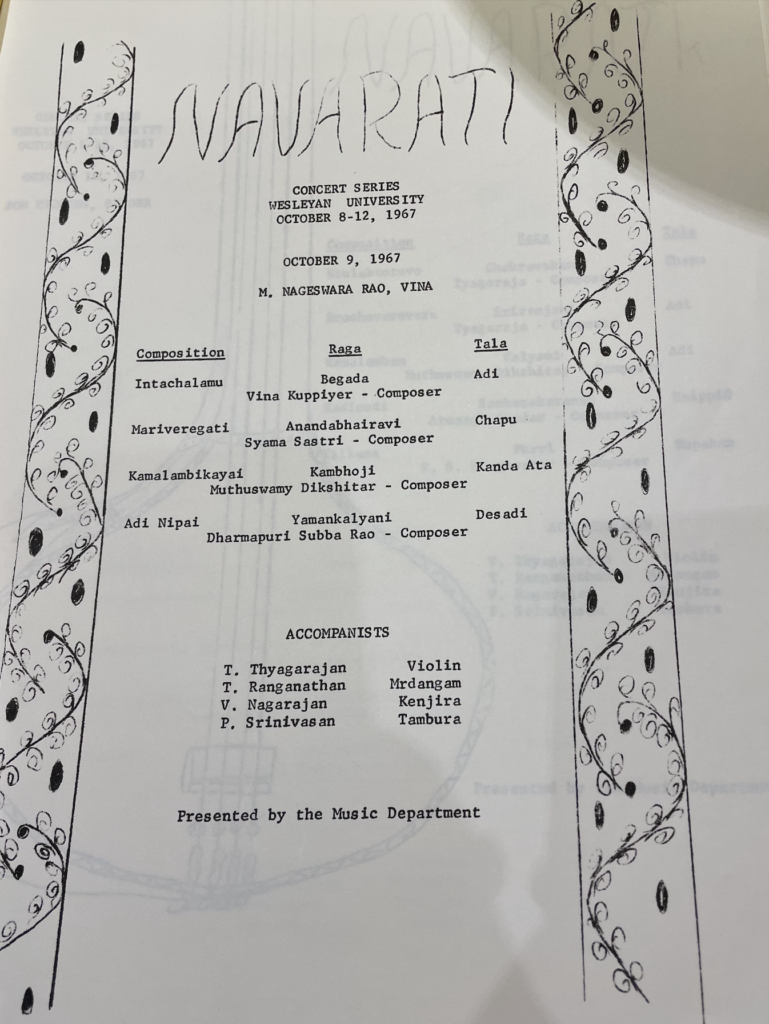
Student Beliefs and the University Campus
Student interests and beliefs affected not only academic offerings at Wesleyan University but also the University’s stance on conflicts like the Vietnam War. In response to protests by Wesleyan students and also by the events at Kent State in Ohio (spurred by the invasion of Cambodia in 1970), President Robert A. Rosenbaum wrote a letter to President Nixon calling for the end of U.S. involvement in Southeast Asia. This letter was dated May 5th, 1970, one day after the deaths of four students at Kent State, and writes that America’s military presence in Vietnam has “been corroding our national spirit in fearful and possibly irreversible ways.” He goes on to write that “higher priority [is] given to developing dreadful modes of warfare than to providing a decent life for our own people” and that it is no wonder that “many young…idealistic people–question whether there is anything good in a system within which this can happen.” President Rosenbaum pleads with President Nixon to “stop the killing now–not next year–or we run the terrible risk of losing all that we hold most dear” (Letter to President Nixon, Henry “Hank” Anderson Papers on Student Activism, Box: 1, Student Activism 1967-1977. Special Collections & Archives.) Student protests have the potential to foster a culture of change and progress that provokes a figure like the sitting president of a university to write a letter to the President of the United States calling for an end to American international wartime policies.
In Conclusion…
With this context of the spiritual effects of the Vietnam War on the psyche of American students, it becomes clear why many members of the counterculture pursued an interest in Eastern philosophies and cultures–namely Hinduism and classical Indian music. The events taking place at Wesleyan University, involving student protests and World Music programming, parallel the wider events occurring across the United States. Ultimately, this history shows us that the interests of students and the beliefs of students have the power to shape the academic offerings of universities and have the power to influence the politics of the university. At Wesleyan, this was demonstrated by the establishment of a doctoral program in Ethnomusicology, and a letter from President Rosenbaum to President Nixon of the United States calling for an end to the war in Vietnam.
Works Cited
Exhibit Objects
Ravi Shankar Flyer: Music Department Records, Box: 3, Folder: 5. Wesleyan University Special Collections & Archives.
Navaratri Program: Music Department programs, Box: 2, Folder:1966-1968. Wesleyan University Special Collections & Archives.
Protest Photo: Student Protest photos 1970-1987, Box: 7, Folder: 1. Wesleyan University Special Collections & Archives.
Letter to Nixon: Henry “Hank” Anderson Papers on Student Activism, Box 1, Folder:1967-1977. Wesleyan University Special Collections & Archives.
World Music Photograph: Music Dept. Series 2: Photographs, Box: 3, Folder: 9. Wesleyan University Special Collections & Archives.
Secondary Sources
Bor, Joep. Asian Music, vol. 29, no. 2, 1998, pp. 129–38. JSTOR, https://doi.org/10.2307/834367. Accessed 28 Feb. 2024.
Craske, Oliver. “Indian Sun: The Life and Music of Ravi Shankar”. Hachette Books, 2020
Keely, Charles B. “Effects of the immigration act of 1965 on selected population characteristics of immigrants to the United States.” Demography, vol. 8, no. 2, 1 May 1971, pp. 157–169, https://doi.org/10.2307/2060606.
`Mitchell K. Hall, The Vietnam Era Antiwar Movement, OAH Magazine of History, Volume 18, Issue 5, October 2004, Pages 13–17, https://doi.org/10.1093/maghis/18.5.13
Pfändtner, Willy. “Hinduism and the 1960s: The Rise of a Counter-Culture, written by Paul Oliver”. Numen 66.2-3 (2019): 328-331. https://doi.org/10.1163/15685276-12341531 Web.
Image Sources
Kent State Shooting, May 4 Collection, Kent State University Libraries, Special Collections and Archives, May 4, 1970
“Public Domain: Protesting the Vietnam War by Frank Wolfe, October 21, 1967 (NARA)” by pingnews.com is marked with Public Domain Mark 1.0.
“Hells Angels Terry The Tramp with Ustad Alla Rakha -Monterey Pop Festival 1967” by Antibubbles is licensed under CC BY-NC-SA 2.0. To view a copy of this license, visit https://creativecommons.org/licenses/by-nc-sa/2.0/?ref=openverse.
Navaratri Concert Programs from October 8-12, 1967 from Music Department Programs Box: 2, Folder 1966-1968. Special Collections & Archives
